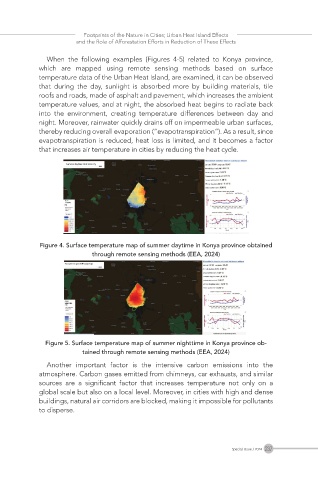Page 250 - Çevre Şehir ve İklim Dergisi İngilizce - Özel Sayı
P. 250
Footprints of the Nature in Cities; Urban Heat Island Effects
and the Role of Afforestation Efforts in Reduction of These Effects
When the following examples (Figures 4-5) related to Konya province,
which are mapped using remote sensing methods based on surface
temperature data of the Urban Heat Island, are examined, it can be observed
that during the day, sunlight is absorbed more by building materials, tile
roofs and roads, made of asphalt and pavement, which increases the ambient
temperature values, and at night, the absorbed heat begins to radiate back
into the environment, creating temperature differences between day and
night. Moreover, rainwater quickly drains off on impermeable urban surfaces,
thereby reducing overall evaporation (“evapotranspiration”). As a result, since
evapotranspiration is reduced, heat loss is limited, and it becomes a factor
that increases air temperature in cities by reducing the heat cycle.
Figure 4. Surface temperature map of summer daytime in Konya province obtained
through remote sensing methods (EEA, 2024)
Figure 5. Surface temperature map of summer nighttime in Konya province ob-
tained through remote sensing methods (EEA, 2024)
Another important factor is the intensive carbon emissions into the
atmosphere. Carbon gases emitted from chimneys, car exhausts, and similar
sources are a significant factor that increases temperature not only on a
global scale but also on a local level. Moreover, in cities with high and dense
buildings, natural air corridors are blocked, making it impossible for pollutants
to disperse.
237
Special Issue / 2024

